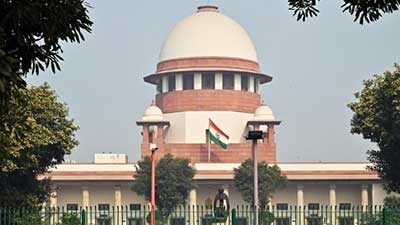Date: 04/05/2023
Relevance: GS-2: Functioning of the Judiciary
Key Phrases: Article 142 of the Constitution, complete justice, irretrievable breakdown of marriage, gender discrimination, care and caution, a mutual agreement to divorce, Section 13B of the Hindu Marriage Act, 1955.
Why in News?
- The Supreme Court of India made a landmark ruling on divorce that could prove beneficial to those seeking to opt out of a bad marriage.
- Leaning on the “guiding spirit” of Article 142(1) of the Constitution to do “complete justice” in any “cause or matter”, a Constitution Bench said it could use this extraordinary discretionary power to grant a divorce by mutual consent to couples trapped in bitter marriages.
- It also aims to spare couples the “agony and misery” of waiting six to 18 months for a local court to annul it, as stipulated under Section 13B of the Hindu Marriage Act, 1955.
Article 142 of the Constitution
- Article 142 of the Indian Constitution empowers the Supreme Court of India to exercise its discretion in the interest of delivering ‘complete justice’.
- The article gives the court the power to pass any order or decree necessary for doing complete justice in any matter, including orders for the investigation, trial, or punishment of any offense, even if the law does not provide for it.
- This provision is unique in that it allows the Supreme Court to depart from established legal norms to deliver justice in exceptional cases.
- The article is often invoked in cases where there is no legal provision to address a particular situation, or when the existing laws are inadequate to provide justice to the aggrieved party.
Current Procedure for Divorce under the Hindu Marriage Act
- Under Section 13B of the Hindu Marriage Act, “divorce by mutual consent” is provided for.
- Both parties to the marriage must jointly file a petition to the district court stating that they have been living apart for one year or more, that they have not been able to live together, and that they have mutually agreed that the marriage should be dissolved.
- According to Section 13B(2) of the Act, the parties must make a second motion before the court “not earlier than six months after the date of the presentation of the [first] petition…and not later than eighteen months after the said date, if the petition is not withdrawn in the meantime.”
- The mandatory six-month waiting period is designed to give the parties time to withdraw their plea.
Observation by the court:
- The Bench observed that the law of divorce, built predominantly on assigning fault, fails to serve broken marriages.
- It pointed out that if a marriage is wrecked beyond hope, the public interest lies in recognizing this fact, not upholding a ‘married’ status regardless.
- The Court said it could use Article 142 to quash pending criminal or legal proceedings, be it over domestic violence or dowry, against the man or woman.
- The Supreme Court could grant a divorce on the grounds of an “irretrievable breakdown of marriage” if the “separation is inevitable and the damage is irreparable”.
- Under the Hindu Marriage Act, irretrievable marriage breakdown is not yet grounds for divorce.
What factors can courts consider while deciding if a marriage has irretrievably broken down?
- The grant of divorce would not be a “matter of right, but a discretion which is to be exercised with great care keeping in mind that ‘complete justice’ is done to both parties.”
- The first and most “obvious” condition is that the court should be fully convinced and satisfied that the marriage is “totally unworkable, emotionally dead and beyond salvation and, therefore, dissolution of marriage is the right solution and the only way forward”.
- Several other factors would be considered by the Supreme Court before
invoking Article 142 in matrimonial cases, including
- Duration of the marriage,
- Period of litigation,
- The time the couple has stayed apart,
- The nature of pending cases, and
- Attempts at reconciliation.
- The Court will have to be satisfied that the mutual agreement to divorce was not under coercion.
Implications for women:
- In India, while divorcees have doubled in number over the past two decades, the incidence of divorce is still at 1.1%, with those in urban areas making up the largest proportion.
- But the divorce numbers do not tell the whole story; there are many women, particularly among the poor, who are abandoned or deserted.
- Census 2011 revealed that the population which is “separated” is almost triple the divorced number.
- In a country that is largely poor, where gender discrimination is rife and many women are still not financially independent, the Court’s stress on “care and caution” and not rushing into a quick divorce must be welcomed.
Conclusion:
- The Supreme Court of India's ruling on divorce is a positive move towards recognizing the reality of broken marriages and granting couples the right to move on with their lives.
- However, the Court's emphasis on "care and caution" and consideration of various factors before granting the divorce is essential to ensure that both parties receive "complete justice."
- This ruling will also benefit women who are often the victims of gender discrimination and lack financial independence.
- Ultimately, the ruling is a step towards marriage equality for all.
Source: The Hindu
Mains Question:
Q. How does the recent Supreme Court ruling on divorce uphold the principle of "complete justice" and address the limitations of the Hindu Marriage Act, 1955? Discuss the factors that the Supreme Court will consider before invoking Article 142 in matrimonial cases and the impact of the ruling on the incidence of divorce in India, particularly for women in the low-income strata.







